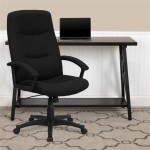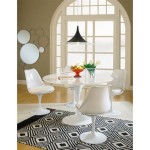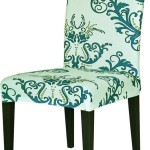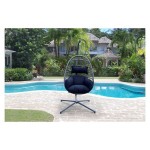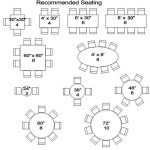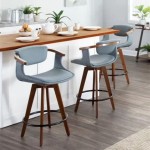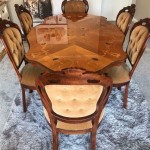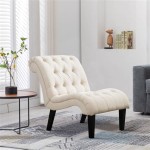Comfortable Chairs for the Kitchen Table: A Guide to Selection and Considerations
Choosing the right chairs for a kitchen table is a significant decision that impacts both the aesthetic appeal and the functional comfort of a home. The kitchen is often a central gathering place, serving as a location for meals, conversations, and even work. Therefore, selecting chairs that are not only visually pleasing but also provide adequate support and comfort is crucial. This article explores various factors to consider when selecting comfortable chairs for a kitchen table, focusing on key aspects of design, materials, ergonomics, style, and maintenance.
Ergonomics and Comfort
Ergonomics plays a vital role in the overall comfort of a kitchen chair. A chair that is poorly designed from an ergonomic perspective can lead to discomfort, fatigue, and even long-term health problems. Seat height is a primary consideration. The ideal seat height should allow individuals to sit with their feet flat on the floor and their knees bent at a 90-degree angle. This posture promotes proper circulation and reduces strain on the lower back. Typically, kitchen tables have a standard height of 30 inches, requiring chairs with a seat height of approximately 18 inches. However, it is essential to measure the specific table height and account for individual preferences.
Seat depth is another important factor. A seat that is too deep can cause individuals to slouch, while a seat that is too shallow may not provide adequate support for the thighs. The ideal seat depth allows for a small gap between the back of the knees and the edge of the seat. This gap ensures that the chair does not impede circulation. Back support is equally crucial. Chairs with adequate lumbar support help maintain the natural curvature of the spine, reducing strain on the lower back muscles. Some chairs feature adjustable lumbar support, allowing individuals to customize the level of support to their specific needs. Additionally, the angle of the backrest should be slightly reclined to promote a comfortable sitting posture.
Armrests can enhance comfort, particularly during extended periods of sitting. Armrests provide support for the arms and shoulders, reducing muscle fatigue. The height of the armrests should be positioned so that the elbows are bent at a 90-degree angle when resting on them. However, some individuals may prefer chairs without armrests to allow for greater freedom of movement. Seat cushioning is another important component of comfort. Cushioned seats provide additional support and reduce pressure on the sit bones. The type of cushioning material used can significantly impact the overall comfort. Foam, memory foam, and gel-infused foam are popular choices, each offering different levels of support and durability. The density of the foam should be sufficient to prevent the seat from bottoming out, even after prolonged use.
Materials and Durability
The materials used in the construction of a kitchen chair significantly impact its durability, comfort, and aesthetic appeal. The frame material provides the structural foundation of the chair and should be chosen based on its strength and stability. Wood is a popular choice for kitchen chairs, offering a classic and timeless aesthetic. Hardwoods such as oak, maple, and beech are particularly durable and resistant to wear and tear. However, wooden chairs may require more maintenance to prevent scratches and water damage. Metal frames, typically constructed from steel or aluminum, offer excellent strength and durability. Metal chairs are often more resistant to scratches and stains than wooden chairs.
The upholstery material plays a significant role in the chair's comfort and aesthetic appeal. Fabric upholstery offers a wide range of colors, patterns, and textures, allowing for easy customization to match the kitchen décor. However, fabric upholstery can be more susceptible to stains and spills. Performance fabrics, which are treated to resist stains and moisture, are a practical choice for kitchen chairs. Leather upholstery offers a luxurious and durable option. Leather is naturally resistant to stains and scratches and develops a unique patina over time. However, leather can be more expensive than fabric. Faux leather, also known as PU leather or vegan leather, provides a similar aesthetic to real leather at a lower cost. Faux leather is typically easier to clean and maintain than real leather.
The finish applied to the chair frame and upholstery can also impact its durability and appearance. A durable finish protects the frame from scratches and moisture damage. Common finishes include varnish, lacquer, and paint. The choice of finish depends on the desired aesthetic and the type of material used. Regular cleaning and maintenance are essential to prolong the life of kitchen chairs. Fabric upholstery should be vacuumed regularly to remove dust and debris. Stains should be treated promptly to prevent them from setting. Leather upholstery should be conditioned periodically to prevent it from drying out and cracking. Wooden frames should be wiped down with a damp cloth to remove dirt and spills. Metal frames can be cleaned with a mild detergent and water.
Style and Design Considerations
The style and design of kitchen chairs should complement the overall aesthetic of the kitchen. A wide range of styles are available, from traditional to contemporary, allowing for customization to suit individual preferences. Traditional kitchen chairs often feature ornate details, such as carved legs and decorative backrests. These chairs are typically constructed from wood and may have fabric or leather upholstery. Contemporary kitchen chairs tend to have clean lines and minimalist designs. These chairs may be constructed from a variety of materials, including metal, plastic, and wood. The color and pattern of the chairs should be chosen to complement the existing décor. Neutral colors, such as white, gray, and beige, are versatile and can be easily integrated into any kitchen design. Bold colors and patterns can add visual interest and personality to the space. However, it is important to consider the overall color scheme and avoid clashing colors.
Chair back height is another design consideration. Low-back chairs provide a more modern and minimalist look, while high-back chairs offer greater support and a more traditional feel. Backless stools can be a space-saving option for small kitchens. The shape of the chair can also contribute to its overall aesthetic. Chairs with rounded backs and seats tend to have a softer and more comfortable feel, while chairs with angular lines have a more modern and structured look. The size of the chairs should be proportional to the size of the kitchen table and the surrounding space. Overly large chairs can make a small kitchen feel cramped, while overly small chairs may look out of place in a large kitchen. It is essential to measure the available space and consider the scale of the chairs before making a purchase.
Mix-and-match chair styles can create an eclectic and visually interesting look. Combining chairs with different colors, materials, and designs can add personality and character to the kitchen. However, it is important to maintain a sense of cohesion by selecting chairs that share a common element, such as color or style. Transparency in chair design, such as chairs made from acrylic or clear plastic, can help to create a sense of openness and airiness in a small kitchen. These chairs allow light to pass through, making the space feel larger and more inviting. Stackable chairs are a practical option for kitchens with limited storage space. These chairs can be easily stacked and stored when not in use, freeing up valuable floor space. Folding chairs provide an even more space-saving option, as they can be folded flat and stored in a closet or pantry.
Ultimately, the choice of comfortable chairs for a kitchen table depends on individual preferences, budget, and lifestyle. Considering the factors outlined in this article can help consumers make informed decisions and select chairs that provide both comfort and style for their kitchen.

Top 3 Reasons You Need Comfortable Dining Room Chairs

Wonder Comfort Comfy Blue Linen Channel Tufted Upholstered Dining Chairs Set Of 4 With Solid Wood Legs Tn 286dc 4bl The Home

Best Dining Chairs 2025 That Are Comfortable And Stylish The Independent

Dining Room Chairs Comfortable Store

Dining Room Furniture Comfortable Backrest Solid Wood Base Leather Cover Chair Outdoor Working Made In Com

Modern Dining Room Kitchen Furniture Board

Kitchen Dining Chairs Comfortable Cloth Covered Soft Bag Dinning Dinner Suitable For Room With Curved Solid Wood Legs Set Of

Modern Dining Chairs For Every Home West Elm

Elegant Solid Wooden Dining Table And 2 Chairs Set Kitchen Furniture White Natural Pine

7 Piece 42x 42 60 Caster Dining Set Laminate Table Top Caramel Chairs
